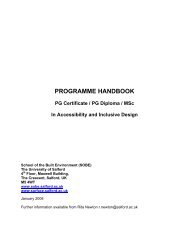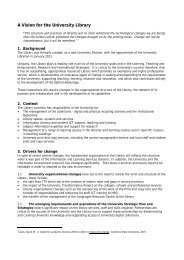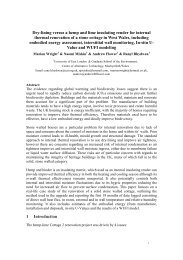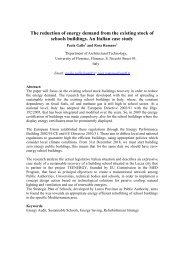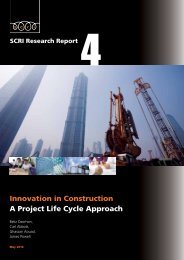Biomedical Research Centre - University of Salford
Biomedical Research Centre - University of Salford
Biomedical Research Centre - University of Salford
You also want an ePaper? Increase the reach of your titles
YUMPU automatically turns print PDFs into web optimized ePapers that Google loves.
Environmental epidemiology <strong>of</strong> Legionella pneumophila, the agent <strong>of</strong> Legionnaires DiseaseLegionella pneumophila is the causative agent <strong>of</strong> Legionnaires Disease (LD), a potentially fatalpneumonic syndrome <strong>of</strong> widely recognised public health importance. Outbreaks <strong>of</strong> LD are commonand are associated with a common environmental infectious source. L. pneumophila is widelydistributed in nature, and is specifically associated with aquatic environments such as water courses,soil and man-made structures such as cooling towers and air-conditioning units. In theseenvironments the bacteria inhabit bi<strong>of</strong>ilms and are pr<strong>of</strong>essional parasites <strong>of</strong> free-living protozoanspecies such as amoebae. The determinants <strong>of</strong> environmental persistent <strong>of</strong> legionellae are poorlyunderstood and it is the overall aim <strong>of</strong> this project to identify and quantify some <strong>of</strong> thesedeterminants. The project will address this aim by (i) monitoring the population dynamics <strong>of</strong>legionellae in natural and artificial (lab-based) niches to elucidate temporal and spatial trends, (ii)characterising the consortia <strong>of</strong> organisms within natural legionella-containing bi<strong>of</strong>ilms to identifyother microorganisms that may facilitate the environmental persistence <strong>of</strong> legionella, and (iii)exploring the specificity <strong>of</strong> L. pneumophila for different free-living protozoan species and quantifingthe dynamics/efficiency <strong>of</strong> parasitism <strong>of</strong> these species. The project will utilize a range <strong>of</strong> traditionaland contemporary molecular microbiological techniques including next-generation sequencingtechnologies to address this aim, and will be based in laboratory with an active and rapidlyincreasing interest in exploring inter-species interactions within polymicrobial bi<strong>of</strong>ilms in a variety <strong>of</strong>ecological settings. The outcomes <strong>of</strong> the project will not only further our understanding <strong>of</strong> thefundamental biology <strong>of</strong> bi<strong>of</strong>ilms but also enhance control <strong>of</strong> L. pneumophila and other pathogensthat exploit bi<strong>of</strong>ilms as niches for their environmental persistence.For further information contact: Pr<strong>of</strong>. Richard Birtles, PhDEmail: r.j.birtles@salford.ac.ukTel: +44 161 2955726Website: http://www.seek.salford.ac.uk/pr<strong>of</strong>iles/RBirtles.jsp
Ecology <strong>of</strong> tick-borne infections.Ticks are one <strong>of</strong> the most economically important arthropod vectors, transmitting bacteria, virusesand protozoa responsible for diseases such as Lyme Borreliosis, Anaplasmosis, tick-borneencephalitis and Babesiosis. As ticks have a complex life cycle, the epidemiology <strong>of</strong> tick-borneinfections is typically difficult to unravel as individual ticks may take their blood meals from a variety<strong>of</strong> vertebrate host species. As such, before we can predict and manage the risks associated withthese infections, it is essential that we have a detailed understanding <strong>of</strong> their ecology. In the UnitedKingdom the sheep tick (Ixodes ricinus) is the principal vector <strong>of</strong> infections <strong>of</strong> medical and veterinaryinterest, including Borrelia burgdorferi, the causative agent <strong>of</strong> Lyme borreliosis. For this project youwill be taking part in a multidisciplinary study with scientists from the <strong>University</strong> <strong>of</strong> <strong>Salford</strong> who haveconsiderable expertise in this field. You will undertake extensive field and laboratory work toincrease our understanding <strong>of</strong> the ecology <strong>of</strong> both the tick vector and the infections that it transmits.In particular you will be addressing questions regarding the distribution and prevalence <strong>of</strong> tick-borneinfections in the United Kingdom, as well as exploring their genetic diversity. You will gainexperience in field ecology, microbiology and data handling and analysis that will help you developas an independent researcher. It is expected that you will present your findings at internationalconferences and publish in high quality peer-reviewed publications.For further information contact: Dr Kevin Bown, PhDEmail:k.bown@salford.ac.ukTel: +44 161 2952351Website: http://www.seek.salford.ac.uk/pr<strong>of</strong>iles/KBown.jspFor further information contact: Pr<strong>of</strong>. Richard Birtles, PhDEmail: r.j.birtles@salford.ac.ukTel: +44 161 2955726Website: http://www.seek.salford.ac.uk/pr<strong>of</strong>iles/RBirtles.jsp
Identification <strong>of</strong> protein partners <strong>of</strong> human NEIL 3The fpg and nei proteins <strong>of</strong> Escherichia coli are DNA glycosylases that act on oxidised bases in DNA,releasing them in the first step <strong>of</strong> base excision repair and thus protecting the genome frommutation. In mammalian cells, three proteins with structural similarities to the fpg/nei family havebeen found and these are termed nei-like (NEIL1, 2 & 3). NEIL3, the largest <strong>of</strong> the three proteins,lacks the conserved active site Pro2 residue, contains an additional tandem zinc ribbon domain at itsC-terminus and exhibits a restricted expression pattern. NEIL3 gene is limited to vertebrates and this,along with its expression in the thymus and spleen, is suggestive <strong>of</strong> a role in antigen–specificlymphocytes. It was also found to be one <strong>of</strong> six host factors essential for HIV replication in an siRNAscreen. The project will focus on the identification <strong>of</strong> protein partners <strong>of</strong> human NEIL3 usingprincipally mammalian 2-hybrid and immunoprecipitation (pulldown) studies. E. coli and mammalianexpression vectors containing full-length and truncated versions <strong>of</strong> the human NEIL3 cDNA areavailable along with antibodies to the expressed proteins. It is expected that the successful applicantwill learn a variety <strong>of</strong> cell biology, molecular biology and proteomic techniques and that they willcontribute intellectually to the experimental design and analysis. These studies should yield valuableclues to the function <strong>of</strong> NEIL3 in human cells and indicate whether it may be a novel target forpharmaceutical intervention in diseases such as lymphoma and leukaemia and in HIV infection.For further information contact: Dr Rhod Elder, PhD (Supervisor)Email: r.h.elder@salford.ac.ukTelephone: +44-161-2953094Website: https http://www.salford.ac.uk/environment-life-sciences/els-academics/rhoderick-elder
Plant Lectins as Cell Penetrating Peptides.RNAi-mediated silencing <strong>of</strong> specific genes is a promising strategy for gene therapy. To utilize RNAi fortherapy, an efficient and safe method for delivery <strong>of</strong> RNA into the cell cytosol is necessary. Theplasma membrane is the primary, and most difficult, barrier for RNA to cross, because negativelycharged RNA is strongly repulsed by the negatively charged membrane. Among the emergingcandidates for RNA carriers are cell-penetrating peptides (CPPs), which can cross the plasmamembrane and internalize into cells together with RNA. Current work focuses on CPP-based RNAdelivery strategies using sub-units <strong>of</strong> cationic plant C-type lectins that have previously been shownto specifically recognize cancer cells based on their sugar binding specificity. This project would befocussed on cloning a portion <strong>of</strong> wheatgerm lectin and generating fusion proteins with GFP toconfirm (a) cellular binding and (b) cellular uptake; ultimately we aim to utilize click chemistry t<strong>of</strong>orm a CPP-siRNA conjugate, alternatively the lectin may be used to deliver a toxin or small moleculeto the cell. Thus this project would provide training in molecular biology (nucleic acid extraction,PCR, cloning, sequencing, protein expression), as well as cell culture. Over a 3- 4 year period severalpublications in Qualis A1 journals would be expected.For further information contact: Dr Natalie Ferry, PhD (Supervisor)Email: n.ferry@salford.ac.ukTelephone: +44-161-2953886Website: https http://www.salford.ac.uk/environment-life-sciences/els-academics/natalie-ferry
Synthesis and Evaluation <strong>of</strong> Novel Agents Targeted at Tubulin and Tumour VasculatureThe development <strong>of</strong> vasculature is critical for the growth and survival <strong>of</strong> tumours. Tumourvasculature therefore represents an important therapeutic target. Recently, antimitoticcombretastatins have been shown to be capable <strong>of</strong> selectively destroying tumour vasculature viadisruption <strong>of</strong> microtubular structures within endothelial cells and are in clinical trial as antivascularagents. Several known antimitotic agents possess a trimethoxy motif which improves their ability tobind to tubulin). This project aims to improve the efficacy <strong>of</strong> non-methoxylated antimitotic agents(eg nocodazole, amphethinile, E7010, TN16) by introducing methoxy groups onto their aromaticrings.The first part <strong>of</strong> the project will entail the synthesis <strong>of</strong> the methoxylated agents. These agents willthen be evaluated for their ability to kill cancer cells and to disrupt the microtubule-tubulinequilibrium.This is a multidisciplinary project and the student would gain skills in chromatography, severalspectroscopic techniques (NMR, UV, Infra-red) and mass spectrometry. The student would learn cellculture techniques, gain experience in synthetic organic chemistry and structure elucidation. Over a3- 4 year period several publications in Qualis A1 journals would be expected.For further information contact: Dr John Hadfield, PhD (Supervisor)Email: j.a.hadfield@salford.ac.ukTelephone: +44-161-2954030Website: http://www.salford.ac.uk/environment-life-sciences/els-academics/john-hadfield
Isolation and Evaluation <strong>of</strong> South American Plant ExtractsApproximately 50% <strong>of</strong> Western drugs are natural products or derived from natural products.Screening <strong>of</strong> plants used in traditional Brazilian medicine would allow the identification <strong>of</strong> the activecomponent(s) and would potentially lead to their synthesis.This project will entail the extraction <strong>of</strong> Brazilian plants and the bioassay-guided fractionation <strong>of</strong> theextracts. The extracts will be initially evaluated on cancer cell lines. An example protocol is below.The project is likely lead to the identification <strong>of</strong> a bioactive agent. This agent would either besufficiently potent for preclinical evaluation or be a lead compound for the synthesis <strong>of</strong> analoguesfor further evaluation.This is a multidisciplinary project and the student would gain skills in chromatography, severalspectroscopic techniques (NMR, UV, Infra-red) and mass spectrometry. The student would learn cellculture techniques, gain experience in synthetic organic chemistry and structure elucidation. Over a3- 4 year period several publications in Qualis A1 journals would be expected.For further information contact: Dr John Hadfield, PhD (Supervisor)Email: j.a.hadfield@salford.ac.ukTelephone: +44-161-2954030Website: http://www.salford.ac.uk/environment-life-sciences/els-academics/john-hadfield
Development <strong>of</strong> molecular epidemiological tools, based on mobile genetic elements, for trackingthe spread <strong>of</strong> Trypanosomes and LeishmaniaThe Kinetoplastid parasites <strong>of</strong> the genera Trypanosoma and Leishmania are responsible for majorhuman and animal disease globally. African sleeping sickness and South American Chagas diseaseare important human diseases caused by T. brucei and T. cruzi while other important animal diseasesare caused by these and other Trypanosoma species. The genus Leishmania causes a wide range <strong>of</strong>human and animal diseases globally. Versatile and generic molecular tools are required for diagnosisand epidemiological tracking <strong>of</strong> these parasites. The genomes <strong>of</strong> representative Kinetoplastids areavailable and they <strong>of</strong>fer the opportunity to be used to design generic molecular tools andapproaches to parasite identification. In <strong>Salford</strong>, we have previously developed epidemiological toolsbased on mobile genetic elements which have been used to track strains <strong>of</strong> T. brucei. The aims <strong>of</strong>this project are to develop innovative bioinformatic approaches and molecular analyses to improvethese tools and to develop similar tools for use in T. cruzi and Leishmania. The project will be nestedwithin a well founded research group, at <strong>Salford</strong> <strong>University</strong>, who use molecular epidemiological toolsfor infectious disease analysis. It is anticipated that this project will result in the publication <strong>of</strong> atleast four high impact peer-reviewed scientific papers (Qualis A1 journals).For further information contact: Pr<strong>of</strong> Ge<strong>of</strong>f Hide, PhD (Supervisor)Email: g.hide@salford.ac.ukTelephone: +44-161-2953371Website: http://www.salford.ac.uk/environment-life-sciences/els-academics/ge<strong>of</strong>f-hide
Delineating inter-species interactions within polymicrobial dental bi<strong>of</strong>ilmsThe oral cavity supports a complex and finely balanced consortia <strong>of</strong> >700 microbial species; many <strong>of</strong>which co-operate within highly structured bi<strong>of</strong>ilms on tooth surfaces and gingival crevices. Changesin oral bi<strong>of</strong>ilm species dynamics are associated with the development <strong>of</strong> periodontal diseases. Thesechronic oral conditions are characterized by inflamed, bleeding gums that can lead to re-adsorption<strong>of</strong> bone and tooth loss.Multiple species <strong>of</strong> oral Streptococci and Veillonella are considered primary colonizers <strong>of</strong> the oralcavity and support the later colonization <strong>of</strong> several Gram-negative anaerobic species that are moreassociated with disease. Three species in particular, Treponema denticola, Porphyromonas gingivalis,and Tannarella forsythia (the red group) have been consistently associated with adult periodontitis.Oral bi<strong>of</strong>ilms have been well characterized and several inter-species interactions have beendescribed. However, most studies have focused on well characterized strains and been limited tojust a few interacting proteins.This project takes a global approach to understanding how bacterial species co-operate inpolymicrobial bi<strong>of</strong>ilms. You will use a range <strong>of</strong> traditional and contemporary molecularmicrobiological techniques including next-generation sequencing technologies. You will be based ina laboratory with an active and rapidly increasing interest in exploring inter-species interactionswithin polymicrobial bi<strong>of</strong>ilms.This project will not only further our understanding <strong>of</strong> the fundamental biology <strong>of</strong> bi<strong>of</strong>ilms, but willalso inform new treatment strategies to maintain a healthy balance <strong>of</strong> microbial consortia in themouth. Anticipated outputs from this project include presentation at national and internationalconferences; and publication <strong>of</strong> several high impact peer-reviewed scientific papers (Qualis A1journals).For further information contact: Dr Chloe E James, PhD (Supervisor)Email: c.james@salford.ac.ukTelephone: +44-161-2952171Website: http://www.seek.salford.ac.uk/pr<strong>of</strong>iles/CJames.jsp
Transcriptional Regulation and Signalling Pathways Mediated by Nuclear Hormone ReceptorsThe long term goal <strong>of</strong> our research is to understand how nuclear hormone receptors control geneexpression and in particular how they regulate cell cycle progression, apoptosis and stress response.We aim to investigate how glucocorticoid receptor (GR) regulates cellular metabolism and to analysethe details <strong>of</strong> its function in particular physiological or pathological conditions. Our lab focuses onstudies <strong>of</strong> the glucocorticoid receptor covalent modifications, the GR interaction with transcriptionalco-factors and new target genes regulated by GR. This research will improve therapy efficiency andhelp minimize unwanted effects <strong>of</strong> steroids that are among most widely prescribed drugs in theworld for diseases such as leukemia, asthma, reumatism, skin conditions, arthritis and numerousother conditions.For further information contact: Pr<strong>of</strong> Marija Krstic-Demonacos, PhD (Supervisor)Email: M.Krstic-Demonacos@salford.ac.ukTelephone: +44-161-2955736Website: http://www.salford.ac.uk/environment-life-sciences/els-academics/marija-krsticdemonacos
DNA damage induced pathways to cancerThe deregulation <strong>of</strong> DNA damage inducible signalling pathways plays major role in the development<strong>of</strong> cancer and analysis <strong>of</strong> components <strong>of</strong> these pathways are vital for diagnosis, prognosis andtherapy <strong>of</strong> malignant tumours. This project will investigate molecular mechanisms <strong>of</strong> how DNAdamage signals are translated to inappropriate function <strong>of</strong> the cell cycle checkpoints, geneexpression and defective apoptosis eventually leading to uncontrollable growth and spread <strong>of</strong>cancerous cells. The involvement <strong>of</strong> the tumour suppressors and histone acetyl transferases in theseregulatory circuits will be analysed using biochemical and molecular biology approaches.For further information contact: Pr<strong>of</strong> Marija Krstic-Demonacos, PhD (Supervisor)Email: M.Krstic-Demonacos@salford.ac.ukTelephone: +44-161-2955736Website: http://www.salford.ac.uk/environment-life-sciences/els-academics/marija-krsticdemonacos
Drug repurposing: A viable option for antimalarial drug discoveryDrug repurposing or repositioning refers to the screening <strong>of</strong> existing drugs for new diseases.Traditional drug development pathways are both costly and time consuming. A significantproportion (90%) <strong>of</strong> the drug candidates investigated fail during drug development. The singularadvantage <strong>of</strong> adopting a repositioning strategy which screens patent expired drug libraries, is thatthe compounds screened are already known to be bioactive and safe for use in humans. Thissignificantly reduces the time and cost involved in drug development.For diseases like malaria where widespread drug resistance has necessitated an urgent need for newdrugs, repositioning may <strong>of</strong>fer an accelerated route to discover potent antimalarials. Furthermore,leads from such screening initiatives could also <strong>of</strong>fer synergistic partners to be used in combinationwith current frontline antimalarial drugs in a bid to delay the spread <strong>of</strong> resistance to these drugs.The proposed project will screen repositories like the Library <strong>of</strong> Pharmaceutically Active Compounds(LOPAC) in vitro culture Plasmodium falciparum. Candidates showing potent antimalarial activity willbe further investigated to enable the systematic and objective definition <strong>of</strong> IC 50 dosages,pharmacokinetics, cytotoxicity and mechanism <strong>of</strong> action. A range <strong>of</strong> methodology including SYBRGreen flow cytometry, fluorescent microtitre assays, proteomics and mass spectrometry will beemployed to achieve stated objectives. The impact <strong>of</strong> the work and its potential contribution to adisease that continues to cause 1-3 million fatalities every year cannot be overemphasised. It isanticipated that this project will also result in the publication <strong>of</strong> at least four high impact peerreviewedscientific papers (Qualis A1 journals).For further information contact: Dr. Niroshini Nirmalan PhD (Supervisor)Email: n.j.nirmalan@salford.ac.ukTelephone: +44-161-2953889Website: http://www.salford.ac.uk/environment-life-sciences/els-academics/niroshini-nirmalan
Development <strong>of</strong> sugars as new anticancer drugsOnce a tumour reaches a certain size (1–2 mm in diameter), it must develop a blood supply in orderto grow larger. Cancer cells secrete substances that promote the formation <strong>of</strong> new blood vessels,which feed the growing tumour - a process called angiogenesis. Interestingly, some tumours alsosecrete substances that inhibit angiogenesis. This explains a clinical phenomenon that has beenknown for decade’s i.e.A patient has a tumour, known as the primary tumour.There is no evidence when first diagnosed that the primary has spread to other parts <strong>of</strong> thebody.A surgeon then removes the primary tumour, unfortunately some weeks later metastases <strong>of</strong>the tumour appear spread throughout the patient's bodyThe speed <strong>of</strong> their appearance indicates that they were present all along but too small to bedetected.This led to speculation that the primary tumour was releasing some biochemical substance thatcould inhibit the growth <strong>of</strong> cancers, which <strong>of</strong> course is <strong>of</strong> great interest in the development <strong>of</strong> newcancer treatments. The project we are <strong>of</strong>fering is aimed at evaluating complex sugars released fromtumour cells and other natural sources as potential therapeutics, utilising a glycomics and structuralbioinformatics approach. Glycomics, is a new and exciting area <strong>of</strong> biological research and scientistsinvolved in it are in great demand in academia and industry. My research group here at the<strong>University</strong> <strong>of</strong> <strong>Salford</strong>, have recently been isolating sugars from many marine sources includingshellfish and testing fragments <strong>of</strong> these sugars to identify those with the best anti-angiogenicproperties. We have now identified a number <strong>of</strong> sugars that show great potential, as the basis fornew drugs, and are currently engaged in a process <strong>of</strong> rational drug design that uses complexcomputer molecular modelling s<strong>of</strong>tware to predict how these sugars bind to the angiogenic factorssecreted from cancers. This information will be used to design and synthesis drugs for the treatment<strong>of</strong> human cancer that mimic the activity <strong>of</strong> these complex sugars”. The PhD project <strong>of</strong>fered will focuson exploring further the results obtained to date, with a view to translating this information into aviable treatment for patients with cancer.For further information contact: Dr David Pye, PhD (Supervisor)Email: D.Pye@salford.ac.ukTelephone: +44-161-2954701Website: http://www.salford.ac.uk/environment-life-sciences/els-academics/david-pye
Developing a sensitive assay to detect Porphyromonas gingivalis species as a mean to safeguardour mouth healthPorphyromonas gingivalis is a major aetiological agent <strong>of</strong> periodontitis, a chronic oral disease,characterized by inflamed, bleeding gums, bone re-adsorption and tooth loss. This anaerobicbacterium uses fimbriae to adhere to oral surfaces and other oral bacteria; aiding assimilation intopolymicrobial bi<strong>of</strong>ilms. Fimbrillin (FimA) is the major fimbrial subunit and is regulated in response toenvironmental conditions. Detection <strong>of</strong> FimA on the bacterial surface during bi<strong>of</strong>ilm developmentwill determine the key conditions required for P. gingivalis binding. This may provide clues for novelstrategies to prevent colonization by this periodontal pathogen.This project aims to develop a rapid and highly sensitive aptamer to detect FimA in dental bi<strong>of</strong>ilmsover a time course <strong>of</strong> development and Porphyromonas gingivalis in human saliva samples. Thiswould help us to understand the role <strong>of</strong> FimA in colonisation <strong>of</strong> the oral cavity. To do this you willdevelop a new recognition tool. Aptamers are a novel and particularly interesting targeting modality,with a unique ability to bind to a variety <strong>of</strong> targets including proteins, peptides, enzymes, antibodiesand various cell surface receptors.To test our hypothesis, you will:Develop aptamers against FimA.Characterise the interactions between selected aptamers and FimA in vitro.Characterise the interactions between selected aptamers and FimA in dental bi<strong>of</strong>ilms.Characterise the interactions between selected aptamers and FimA in saliva samples.It is anticipated that this project will also result in the publication <strong>of</strong> at three four high impact peerreviewedscientific papers (Qualis A1 journals).For further information contact: Dr Patricia A Ragazzon, PhD and Dr Chloe E James (Supervisors)Email: p.a.ragazzon@salford.ac.uk / c.james@salford.ac.ukTelephone: +44-161-2955978 / +44-161-2952171Website: https://www.seek.salford.ac.uk/pr<strong>of</strong>iles/PRagazzon.jsphttps://www.seek.salford.ac.uk/pr<strong>of</strong>iles/CJames.jsp
Development <strong>of</strong> new anti-trypanosome agents based on natural productsChagas disease, caused by Trypanosoma cruzi, affects 10 million people in Latin America and isresponsible <strong>of</strong> 20,000 deaths/year. Telomeres are non-coding DNA regions located at the end <strong>of</strong>chromosomes, protecting them from erosion, fusion and assisting during replication. Thesestructures are present in diverse organisms such as trypanosomes and humans, the sequences varydepending to the organism and in vitro, they form G-quadruplex structures. Telomarase is anenzyme that adds DNA sequence repeats to the telomere region. Every time a cell divides, thetelomere shortens and after 60-70 rounds <strong>of</strong> replication, the cell enters apoptosis. In around 85% <strong>of</strong>cancers this enzyme is activated and it has been found to be activated in trypanosomes as well, astelomerase is inactive in normal most somatic cells, attacking the telomere/telomerase interaction isan innovative and attractive target for treating parasitic diseases.Our aim is to develop a new family <strong>of</strong> anti-parasitic agents, as a PhD student you will synthesisecompounds based on natural products and test their efficacy in several strains <strong>of</strong> microbiologicalrelevance. You will also characterise the telomere-drug interactions using biophysical techniquesproducing structure activity related studies (SARS) data that will help you to design new molecules.The results <strong>of</strong> this PhD project have the potential <strong>of</strong> validating G-quadruplex DNA structures as invivo targets for the treatment <strong>of</strong> parasitic diseases, and the production <strong>of</strong> a new generation <strong>of</strong> antitrypanosomeagents. It is anticipated that this project will also result in the publication <strong>of</strong> highimpact peer-reviewed scientific papers (Qualis A1 journals).For further information contact: Dr Patricia A Ragazzon, PhD (Supervisor)Email: p.a.ragazzon@salford.ac.ukTelephone: +44-161-2955978Website: https://www.seek.salford.ac.uk/pr<strong>of</strong>iles/PRagazzon.jsp
Diversity and pathogenesis <strong>of</strong> the zoonotic parasite Toxoplasma gondii.Toxoplasma gondii is one <strong>of</strong> the most common zoonotic pathogens worldwide. The parasite cancause serious congenital disease in humans and animals and is potentially fatal to individuals withHIV. Our laboratory has isolated parasite strains from domesticated animal species in Africarevealing that they are closely related to clonal strain types (II and III) which dominate across Europeand North America. We also discovered that recombination between these strains occurs in natureand further generated whole genome sequence for our recombinant isolate identifying over 74,000Single Nucleotide Polymorphism’s . Our analysis allowed us map regions with high levels <strong>of</strong> variationand loci under selection providing markers to investigate the diversity <strong>of</strong> strains in relation to diseasephenotype. Based on these new tools we now wish to investigate the frequency <strong>of</strong> recombinationand its impact on the disease virulence. Our aim is now to move from Africa to South America,where the parasite has high levels <strong>of</strong> variation and recombination. The project will isolate andcharacterise strains from rural and urban habitats using genetic analysis to detect recombinationand in vitro culture to investigate virulence associated traits.For further information contact: Pr<strong>of</strong> Judith Smith, PhD (Supervisor)Email: j.e.smith@salford.ac.ukTelephone: +44-161-2955171Website: http://www.salford.ac.uk/environment-life-sciences/els-academics/judith-smith







